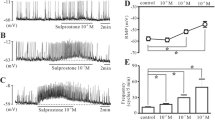Abstract
The source, time course and stoichiometry of cytosolic free Ca2+ ([Ca2+]i) during contraction were examined in smooth muscle cells isolated from the guinea pig and human stomach. Contraction by receptor-linked agonists (eg, acetylcholine, cholecystokinin octapeptide and Met-enkephalin) was preceded by stoichiometric increases in [Ca2+]i and net 45Ca2+ efflux that were maintained in the absence of extracellular Ca2+ or in the presence of a Ca2+ channel blocker (13600). The intracellular Ca2+ store could be depleted by repeated stimulation with all agonists in Ca2+-free medium or in the presence of 13600 resulting in loss of contractile response; response was restored by re-exposure of the cells to Ca2+.
The source of intracellular Ca2+ an the signal for its release were examined in saponin-permeabilized muscle cells. The cells retained their ability to contract in response to receptor-linked agonists and developed an ability to contract in response to inositol trisphosphate (IP3). The cells accumulated Ca2+ to the same extent as intact muscle cells, but only in the presence of ATP. IP3 caused a prompt, concentration-dependent increase in contraction, [Ca2+]i and net 45Ca2+ efflux. These effects were maximally similar to those produced by CCK-8 alone or in combination with IP3: Depletion of the Ca2+ store by repeated stimulation of single muscle cells in Ca2+-free medium with IP3, acetylcholine or CCK-8 separately resulted in loss of contractile response to all three agents; the response was restored by re-exposure of the muscle cell to a cytosol-like perfusate (Ca2+ 180 nM).
The studies demonstrate that a product of membrane phosphoinositide hydrolysis is capable of mobilizing Ca2+ from a depletable, non-mitochondrial intracellular store that is utilized by receptor-linked agonists. The magnitude of IP3-induced Ca2+ release is correlated with contraction.
Similar content being viewed by others
References
Berridge MJ, Irvine RF: Inositol trisphosphate, a novel second messenger in cellular signal transduction. Nature 312:315–321, 1984
Burgess GM, Godfrey PP, McKinney JS, Berridge MJ, Irvine RF, Putney Jr JW: The second messenger linking receptor activation to internal Ca release in liver. Nature 309:63–66, 1984
Streb H, Irvine RF, Berridge MJ, Schulz I: Release of Ca2+ from a nonmitochondrial intracellular store in pancreatic acinar cells by inositol-1,4,5-trisphosphate. Nature 306:67–68, 1983
Suematsu E, Hirata M, Hashimoto T, Kuriyama H: Inositol 1,4,5-trisphosphate releases Ca2+ from intracellular store sites in skinned single cells of porcine coronary artery. Biochem Biophys Res Commun 102:481–485, 1984
Bitar KN, Makhlouf GM: Receptors on smooth muscle cells: characterization by contraction and specific antagonists. Am J Physiol 242:0400–0407, 1982
Bitar KN, Makhlouf GM: Measurement of function in isolated single smooth muscle cells. Am J Physiol 250:0357–0360, 1986
Bitar KN, Burgess GM, Putney JW Jr, Makhlouf GM: Source of activator calcium in isolated guinea pig and human gastric muscle cells. Am J Physiol 250:280–286, 1986
Bitar KN, Bradford P, Putney Jr JW, Makhlouf GM: Cytosolic calcium during contraction of isolated mammalian gastric muscle cells. Science 232:1143–1145, 1986
Bitar KN, Bradford PG, Putney Jr JW, Makhlouf GM: Stoichiometry of contraction and Ca2+ mobilization by Inositol 1,4,5-trisphosphate in isolated gastric smooth muscle cells. J Biol Chem 261:16591–16596, 1986
Tsien RY, Pozzan T, Rink TJ: Calcium homeostasis in intact lymphocytes: cytoplasmic free calcium monitored with a new intracellularly trapped fluorescent indicator. J Cell Biol 94:325–334, 1982
Somlyo AV, Bond M, Somlyo AP, Scarpa A: Inositol trisphosphate-induced calcium release and contraction in vascular smooth muscle. Proc Natl Acad Sci USA:82:5231–5235, 1985
Grider JR, Bradford PG, Makhlouf GM: Contraction mediated by calcium (Ca2+) influx in longitudinal and Ca2+ release in circular muscle cells of intestine. (Abstr) Gastroenterology 90:1440A, 1986
Yee SY, Grider JR, Makhlouf GM: Regulatory role of protein kinase C (PKC) in contraction of isolated longitudinal and circular muscle cells of intestine. (Abstr) Gastroenterology 92:1614, 1987
Author information
Authors and Affiliations
Rights and permissions
About this article
Cite this article
Makhlouf, G.M. Ca2+ release and contraction induced by IP3 and contractile agonists in mammalian gastric smooth muscle. Mol Cell Biochem 82, 137–143 (1988). https://doi.org/10.1007/BF00242529
Accepted:
Issue Date:
DOI: https://doi.org/10.1007/BF00242529




